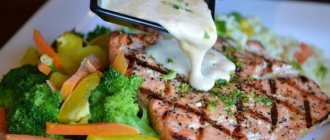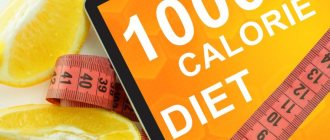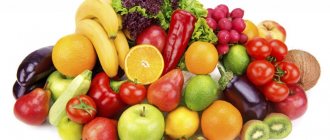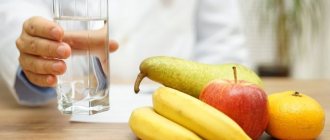The Danish diet is based on the principle: the more effort you put into achieving a slim figure, the better the result. In 13 days of the course, you lose from 7 to 20 kilograms of excess weight. But that’s not all: the achieved weight lasts for two years, even when returning to your usual eating style. However, such an impressive result can be achieved under one condition: you must strictly follow the rules of the diet; the slightest deviation from the nutritional system will reduce the effectiveness to nothing.
The essence of the diet and principles of action
The diet was created by specialists from the Danish Royal Hospital. At its core, this is a course of therapy that is aimed at restoring metabolism. The set of products, their combinations and daily portions are carefully verified in this system.
The main rule of the Danish Royal Hospital diet is to limit calories to 600-800 kcal. The menu is strictly regulated and it is prohibited to make any amendments to it. Having studied the diet, it is easy to understand that an adult will not receive the daily energy requirement (2000-2500 kcal).
The developers of the Copenhagen diet proceeded from the idea that in order to obtain the desired effect, it is necessary to create an acute calorie deficit, that is, a situation where a person expends more energy than he receives from food. Thanks to this, the body will begin to use its own fat reserves to produce energy. But weight loss is not only associated with the loss of adipose tissue.
In addition to this rule, there are several more recommendations:
- You must strictly follow the daily menu, you cannot add other drinks and foods, and you cannot exclude anything. If desired, portions can be reduced, but increased is prohibited.
- Drinking water is the only component that is not limited in any way by diet. You can drink as much as you need, but the water must be clean, that is, not mineral or carbonated.
- During the diet, it is recommended to save energy and avoid physical and emotional stress. It's best to do therapy while you're on vacation because stress at work can lead to relapse.
- The diet must be stopped if a person feels a deterioration in health, so as not to harm the body.
- You can use the diet no more than once every 2 years. If a breakdown occurs, the therapy is completed, since the desired effect can no longer be obtained.
Danish 4 palms diet
Normal weight is the norm for a person, an indicator of health and good metabolism. There are many people who are dissatisfied with their weight, both in the direction of excess and deficiency. This article will talk about losing excess weight using the Danish Four Palms Diet.
Is it possible to control the amount of food eaten, lose weight and at the same time receive all the vitamins and elements necessary for the body?
Who invented the 4 palms diet
Nutritionists are unanimous in their opinion that the diet should be balanced. This will have a positive impact on both weight loss and overall health. In this case, the possibility of breaking down due to the frequent need for food is excluded. Danish nutritionist Suzy Wengel has developed a diet based on a balanced diet.
The book “The Scandi Sense Diet” brought fame to the nutritionist. She was enthusiastically received in the Scandinavian countries. Here Susie shares her weight loss experience: in 1 year she managed to lose 38 kg. Before this, her weight was more than 100 kg.
Now the author continues to work on his figure, although he is in excellent shape. They say correctly: there is no limit to perfection. Her experience is also interesting for women who have given birth and have recovered after childbirth. Susie herself has five children.
She knows from her own experience what a problem with weight “swing” means.
The diet proposed by the author is quite simple. This is partly why the diet is becoming increasingly popular.
The essence of the diet
The meaning of the Danish diet is to strictly adhere to the volume of consumed part of the main food. It should fit in 4 handfuls of palms. Meals are usual, three times a day.
Basic nutrition
Vegetables, salad, greens should fit in a total of two palms. It is necessary to exclude legumes, potatoes, sweet potatoes. You can take smaller quantities. You need to focus on the feeling of fullness. The next, 3rd palm, contains only carbohydrates.
We are talking about complex carbohydrates, such as rice, pasta, bread, berries. There is an option to replace carbohydrates with vegetables, herbs, and protein.
The 4th palm contains exclusively protein foods: seafood, legumes, cheese, eggs, meat. Denmark does not have cottage cheese, so it is not mentioned in the book.
According to the advice of Russian nutritionists, it can also be included in the “4th palm”.
Fats
It is imperative to include fats in your diet. They eliminate skin problems and can be an addition to the main diet. Fats are found in:
- Vegetable oil and butter;
- Nuts, seeds;
- Avocado;
- Fatty cheeses;
- Dark chocolate.
The permitted amount of dairy products is 300 grams per day. Selected depending on personal taste preferences. Suitable as a snack between main meals.
Drinking regime
It is enough to drink a liter and a half of clean water daily. Tea and coffee are allowed, only without added sugar.
Treats
Susie's diet allows her to consume various store-bought sweets: candy, chips, cakes, smoked meats, ice cream. A prerequisite: portions should be small and such “joys” should be allowed no more than once or twice a week.
Most likely, the need for these products may weaken, or even disappear completely, provided that you have a properly balanced diet. As a result, excess weight will be lost. As a rule, various kinds of “goodies” lead to excess kilograms.
Why is it effective?
The effectiveness of the Danish diet lies in three components:
- Balanced diet. The diet contains all the necessary elements, as a result of which there is no overeating or breakdowns in eating;
- Sufficient amount of food. Four handfuls are enough to meet your daily calorie needs;
- There are no strict prohibitions on food consumption. You can sometimes allow sweets, cakes, and so on. Of course, in moderation.
The effect of the diet depends on your initial weight. On average, there is a constant loss of 400 to 800 grams in 7 days.
Are there any contraindications?
The Danish Four Palms Diet is a gentle diet, so there are no contraindications or restrictions in its use. The diet is balanced, the body receives all the necessary nutrients.
This diet can be used for a long time and even made into a regular diet. Provided there are no restrictions prescribed by the doctor.
You should remember:
- The measuring unit for portions is the palm of your hand;
- The ratio of vegetables, greens: carbohydrates: proteins is 2:1:1;
- Every day you need to drink a sufficient amount of water, at least one and a half liters;
- The diet should contain fats;
- “Treats” are allowed in reasonable quantities.
The Danish diet for losing excess weight is perfect for anyone who wants to lose weight or simply get in shape. It is so balanced that you can follow it for a long time. There are no special contraindications.
Share the page with your friends
Source: https://lady-gerl.ru/datskaya-dieta-4-h-ladonej
Advantages and disadvantages
Many people praise the Danish diet, and there are several reasons for this:
- Availability. Almost all products that are included in the daily diet are easily accessible and can be purchased at any store. But you need to monitor the quality and composition of food, since the diet involves consuming only natural food.
- Having a clear plan that includes breakfast, lunch and dinner. This allows people, especially those inexperienced with diets, to avoid the task of counting calories.
- Metabolic balance and preservation of the result for 2 years, subject to a return to a normal diet and lifestyle.
The Copenhagen diet, despite its high efficiency and severity, if used incorrectly, can destroy the human body. For this reason, it is forbidden to practice it for more than 13 days, because it causes many unpleasant consequences.
This is primarily manifested by a deficiency of essential vitamins and minerals, which leads to dizziness and frequent fainting. Also, this type of nutrition negatively affects a person’s concentration, preventing concentration during any activity. Such symptoms are temporary and disappear after returning to your normal lifestyle, so they do not threaten your health.
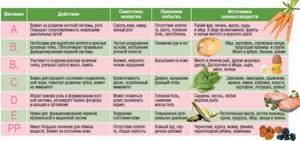
Content of vitamins in food products.
Why is it effective?
The whole secret is in three components of this system:
- balance (you have enough of the necessary elements, therefore, you feel full and you don’t want to overeat);
- quantity (four handfuls of food at each meal is approximately 2,000 kcal for men and 1,500 kcal for women);
- the absence of strict prohibitions (you don’t need to refuse treats so as not to lapse later - it’s better to control their quantity).
The result of losing weight depends on the initial weight, but on average it is 400–800 g per week until the optimal weight is reached.
Authorized Products
The diet of the Danish Royal Hospital is one of the strictest, which is why the list of allowed foods is short. Nutritionists advise purchasing all the necessary products in advance so as not to be tempted to eat something tasty again. List of allowed foods:
- Purified drinking water.
- Coffee.
- Bran bread.
- Ham, chicken fillet, lean beef.
- Cod fillet.
- Vegetables.
- Fruits.
- Orange juice.
- Refined sugar.
- Greenery.
All other products are strictly prohibited.

Reviews
Angelina, 27 years old, Novosibirsk : “This diet is for those who cannot refuse coffee with cane sugar in the morning: the 13-day diet is the only one that allows this drink. The second plus for me of this diet is cabbage on the menu. I love cabbage, not for its taste, but for its cleansing properties. On the third day of the diet, I felt light, my stomach literally fell in, it seemed that the cabbage had swept away everything it could (it acts like a laxative on me).
The first days were hard, I was hungry, but as soon as the jeans began to hang at the waist and hips, I forgot about hunger and, inspired by the result, easily stuck to the plan for the remaining days. Now about the numbers. On the third day the scales showed 57 kg (it was 59), on the 13th day - 53 kg! My height is 168 cm, 27 years old.”
Terentyev Grigory Viktorovich, nutritionist, Moscow : “The Copenhagen diet is based on three meals a day in the form of breakfast, lunch and dinner. Breakfast consists of black coffee with 1 spoon of sugar. Drinking the drink is necessary to provide the body with energy, but coffee also helps flush out magnesium and iron. When using the Copenhagen diet, lunch should be consumed no later than 14-00, and dinner – 18-00. The calorie content of food consumed should not exceed 500-900.
The Copenhagen Diet is not intended for people in poor health, those suffering from hypertension and stomach diseases, or those who engage in sports or heavy physical work. This diet is contraindicated for pregnant and lactating women.
My colleagues have different opinions about it. The first consider its use advisable for quickly getting rid of extra pounds, regulating metabolism and speeding it up. Others criticize this diet, considering it poorly balanced and destructive to the body. However, according to most experts, the diet does not cause harm if you apply it in accordance with the rules and do not repeat it more than once a year.
Therapy should last exactly 13 days. It is associated with a strong reduction in the dose of calories, vitamins and minerals taken. For this reason, using the Copenhagen diet may lead to fainting, dizziness and general weakness of the body. Concentration ability is often reduced and memory problems occur. I rarely prescribe it to my patients because I prefer less restrictive and complex diets.”
Menu for 13 days
First week
First day:
- Breakfast: strong coffee, a piece of refined sugar (sugar should be eaten separately, not added to coffee).
- Lunch: 2 boiled chicken eggs, 200 g of boiled broccoli, large tomato.
- Dinner: a piece of beef, baked in the oven or grilled, 250 g of fresh vegetable salad, seasoned with 1 tsp. vegetable oil and lemon juice.
Second day:
- Breakfast: a cup of coffee, a cube of refined sugar.
- Lunch: 200 g of low-fat ham, a glass of drinking yogurt or low-fat kefir.
- Dinner: a piece of lamb, cooked in the oven, 200 g of vegetable salad.
The third day:
- Breakfast: coffee, a lump of sugar, toast or a piece of normal bread, preferably gray or bran.
- Lunch: 250 g lean ham, 2 boiled eggs, 3 fresh lettuce leaves.
- Dinner: boiled broccoli, large tomato, apple or orange.
Fourth day:
- Breakfast: coffee, a little sugar, a piece of bran or gray bread.
- Lunch: 1 liter of orange juice, a glass of drinking yogurt or kefir.
- Dinner: hard-boiled chicken egg, grated carrots, 150 g of natural cottage cheese without added sugar.
Fifth day:
- Breakfast: grated carrots with lemon juice.
- Lunch: 400 g of boiled cod fillet with vegetable oil.
- Dinner: a piece of beef, grilled, 150 g of vegetable salad, dressed with olive oil.
Sixth day:
- Breakfast: strong coffee, sugar cube, piece of bran bread.
- Lunch: 2 boiled eggs, grated carrots.
- Dinner: half a boiled chicken without skin, vegetable salad with vegetable oil.
Seventh day:
- Breakfast: a cup of coffee.
- Lunch is skipped.
- Dinner: a large piece of fried beef, 3 small allowed fruits.
Second week
First day:
- Breakfast: strong coffee, a cube of refined sugar, a piece of gray bread.
- Lunch: 250 g of lean ham, 2 boiled eggs, 3 lettuce leaves.
- Dinner: boiled celery, large tomato, grated apple.
Second day:
- Breakfast: coffee, sugar.
- Lunch: 250 g of lean ham, 350 g of drinking yogurt or low-fat kefir.
- Dinner: a piece of beef, cooked in the oven, 250 g of vegetable salad with lemon juice, a small apple.
The third day:
- Breakfast: a cup of coffee, a sugar cube, a piece of bran bread.
- Lunch: 250 g of lean ham, 2 boiled eggs, several lettuce leaves.
- Dinner: boiled broccoli, 1 large tomato, apple.
Fourth day:
- Breakfast: a cup of coffee, a little sugar, a piece of brown bread.
- Lunch: 1 liter of orange juice, a glass of drinking yogurt or kefir.
- Dinner: boiled egg, grated carrots, 150 g of natural cottage cheese without sugar.
Fifth day:
- Breakfast: grated carrots with lemon juice.
- Lunch: 450 g of boiled pike perch with lemon juice and butter.
- Dinner: a piece of meat baked in the oven, 250 g of vegetable salad.
Sixth day:
- Breakfast: a cup of strong coffee, a cube of sugar, a piece of bran bread.
- Lunch: 2 boiled eggs, 1 grated carrot.
- Dinner: 300 g of boiled chicken without skin, vegetable salad with lemon juice.
Scandinavian diet for weight loss
Weight loss, Nutrition, Recipes
March 14, 2018
Nutritionists recommend pineapples, avocados, chia seeds and other exotic products, which in our latitudes are found in supermarkets and never in gardens, forests or vegetable gardens.
Therefore, the desire to adhere to an exotic diet results in expenses for which you can live for a month in the place where suppliers bring these same avocados and pineapples. Fortunately, there is a diet adapted to northern latitudes that suits a moderate budget.
It is called the “Nordic”, “Norwegian” and even the Viking diet. But its most common name is the Scandinavian diet.
Klaus Meyer is considered the creator of the Scandinavian diet. He is not a doctor or a nutritionist, but a restaurateur from Copenhagen. In 2004, Meyer noticed how demand for nutritional supplements and processed foods had increased. He convened a symposium of restaurateurs, which resulted in a manifesto for new Nordic cuisine.
The manifesto argued that Scandinavia provides its residents with enough healthy and tasty products, and no matter how attractive exotic and semi-finished products are, it is worth popularizing its own, healthy and inexpensive products.
Based on this manifesto, nutritionists at the University of Copenhagen developed the “New Scandinavian Diet,” which is now in demand all over the world.
The essence of the Scandinavian diet
This diet suggests abandoning artificial, unhealthy foods with synthetic additives, flavor stabilizers, emulsifiers and dyes in favor of natural, environmentally friendly products.
Imagine what products would be at your disposal if there were no food concerns, poultry farms and other mass producers. According to Meyer and his colleagues, preference should be given to vegetables and fruits grown in a farmer's garden rather than in a corporation's greenhouse.
And instead of meat from the slaughterhouse, look for poultry or game.
The fact is that the body of residents of different latitudes is genetically predisposed to the food that is available in their native region. The peoples of the tundra got by with very little plant food, but their diet included a lot of meat and fat.
However, if a resident of sunny India, with its abundance of fruits, tries to eat like a person from the north, he will develop an upset stomach and problems with metabolism.
But in a global sense, this is exactly what happens to residents of all developed countries: a lot of atypical food penetrates into the city dweller’s diet, to which the body is poorly adapted. Therefore, Danish nutritionists recommend returning to a more natural diet.
The “Norwegian” system also suggests giving up confectionery and alcohol, as well as baking from white flour.
For Scandinavia, with its small amount of arable land, rich bread, buns and loaves were a rare occurrence for a long time; the descendants of the Vikings are unfamiliar with the expression “bread for everyone.”
Canned food and fast food are also banned: it is recommended to avoid ready-made dumplings, pancakes, noodles and instant soups.
Main principles of the diet
The Scandinavian diet recommends sticking to the golden mean: you don’t need to deplete yourself by starving, but you shouldn’t overeat either. The optimal diet is 5 times a day in small portions of 200-250 grams. You shouldn’t overeat before bed, and if you want to eat so much that you can’t sleep, it’s better to drink a glass of milk, yogurt or kefir.
The second principle is to cook homemade food and not add artificial food additives. You should not completely give up salt, but its use should be limited: do not over-salt foods, do not add salt when it is not needed. For example, in Russia fresh vegetables are often added: cucumbers, tomatoes. The Scandinavian system does not recommend this.
The third principle is to avoid frying in a pan. Instead, you can bake dishes in the oven, boil, stew, or prepare fresh salads.
The fourth principle is to limit the consumption of animal fats. Give preference to lean meat, and where possible, replace it with fish and seafood.
Of course, the Scandinavian food system gives preference to fish caught in the northern seas. It is rich in heart-healthy omega-3 fatty acids.
When cooking, you should give preference to vegetable oils: sunflower, flaxseed, rapeseed.
The fifth principle is to eat fresh vegetables and fruits. Do not limit yourself to a couple of familiar vegetables - for example, tomatoes, cucumbers, carrots, but try to include as many green, red, yellow vegetables in the menu as possible. Choose seasonal products that grow in your native land, because the body absorbs them well.
The sixth principle - try to pamper yourself with forest products and gifts of wild nature. Of course, this is not so simple if we are talking about venison or elk meat, but in Russia it is quite possible to find wild berries during the season: cranberries, cloudberries, blueberries or lingonberries.
Finally, you shouldn’t give up bread, but you should choose varieties rich in fiber: for example, rye or black bread.
List of allowed foods during the diet
- Whole grains: bran, barley, brown rice, green buckwheat. It is recommended to exclude white rice, as well as semolina porridge, millet, corn flakes and pastry dishes.
- Dairy products: milk and cottage cheese. Powdered milk, which is on supermarket shelves, is not recognized by the Scandinavian diet. Dairy products should be purchased from farmers. For residents of big cities, this means the need to go to the market.
- Vegetables and fruits: all without exception, and as often as possible, as varied as possible. Preference should be given to those vegetables and fruits that grow in your region: apples, raspberries, currants, cabbage, but fruits from hot countries are not prohibited.
- Forest food: mushrooms, nuts, bark, acorns, moss. You should collect all this with caution and buy it too, because you must be sure of the organic origin of the products and their suitability for food. Not every moss can be eaten.
- Poultry meat. Meat consumption should be kept to a minimum, choosing, whenever possible, poultry raised in natural conditions and not in a poultry farm. Eliminate sausages and sausages from the diet completely.
- Fish and seafood. Ideally, you need to find fish that were caught from a natural reservoir. Squid, shrimp, eel, oysters, and seaweed should also be included in the diet.
Menu for the week
The “Norwegian” nutrition system does not require any strict schedule; everyone can improvise to their taste, adhering to the basic principles. But to illustrate the approach, we recommend this weekly diet.
- Breakfast: oatmeal with berries, muesli with yogurt, cottage cheese with berries, omelette with steamed spinach or cooked in the oven.
- Second breakfast: fish or chicken cutlet with rye bread, sandwich with liver pate or cheese, almonds.
- Lunch: fish soup, rassolnik or borscht - for the first course; baked fish, potatoes with vegetables or mushrooms, stewed beans, goulash and pearl barley - for the main course; carrots, beets, cabbage, nuts, garlic, radishes - in the salad.
- Afternoon snack: cottage cheese with berries, yogurt or baked apples.
- Dinner: stewed vegetables, baked fish or poultry.
Menu for 1 day
- For breakfast - a steamed omelette with milk, a slice of black or rye bread, kefir.
- For second breakfast – walnuts with honey.
- For lunch you need to prepare two dishes: mushroom soup, barley with baked fish, cucumber, tomato and onion salad.
- For an afternoon snack - yogurt.
- For dinner - brown rice risotto.
Experiment with your diet, choosing foods and recipes that you like. Do not force yourself to eat what is on the list of allowed foods if it does not seem tasty.
In order for a feeling of fullness to occur on time, food must be tasty.
Pros and cons of the diet
The Scandinavian nutritional system has a good effect on metabolism, it strengthens the immune system, and improves the health of internal organs. All these improvements cannot but affect their appearance, so supporters of the technique look younger than their age.
This mode has few disadvantages, and they are relative. For example, if you want to lose weight “by the summer”, “by the New Year” or “by the reunion so that you can fit into your school dress”, then you need to switch to the Scandinavian system six months before this significant event, because you will lose weight lose gradually, but not to the detriment of health.
If you love juicy steaks, French fries and processed foods, the downside of this approach is the fact that you need to stick to a healthy menu all the time. This is not an option when you can sit on a low-calorie diet for a couple of months, take a photo for a new VKontakte avatar, and then calmly eat burgers.
This is a complete healthy eating philosophy.
One of the disadvantages is that the method is not suitable for vegetarians, vegans and people with allergies to fish and seafood.
Weight Loss Results
When nutritionists from Copenhagen first developed the diet, they did not set themselves the goal of creating a menu for weight loss, but were going to offer a healthy diet for residents of northern latitudes. However, the theory required testing, so nutritionists recruited volunteers, who were then divided into two groups.
The first ate processed grains, sugar and other unhealthy foods. The second adhered to the new Scandinavian system. The results were unexpected: not only did the blood pressure of people in the second group normalize, the functioning of their internal organs improved, but their weight returned to normal.
Each of the participants lost from 3 to 15 kg during the experiment.
The Scandinavian diet does not give rapid results, so do not expect to lose 15 kg in the first month. However, this is not only normal, but also correct: a healthy rate of weight loss that is not dangerous to the body is about 5 kg per month. Diets that promise dramatic weight loss are fraught with exhaustion of the body and rapid weight regain in the future.
Alternative to the Scandinavian diet
If you are not satisfied with the methods of this diet, or you don’t have time to cook, and you want to get quick results without harm to your health, then choose our thoughtful and healthy weight loss menu for the week:
Source: https://letbefit.ru/blog/skandinavskaya-dieta-dlya-pokh/
How to get out of a diet correctly
To painlessly exit the Danish Royal Hospital diet, you must adhere to several rules:
- The amount of fruits and vegetables consumed should be increased gradually, preferably boiled.
- Increasing consumption of lean meats.
- Within 2 weeks, you need to add 200 calories to your daily diet in the form of dark chocolate and whole grain bread.
- It is advisable to start physical labor with a minimum load, gradually increasing it. This is due to the fact that after completion of therapy the body is weakened. It is necessary to increase the number and intensity of training every week, and it is recommended to start with simple walking, cycling and gymnastics.
- Drink at least 2 liters of water daily, taking into account that this amount includes only herbal tea, freshly squeezed juice and purified water.
- Also, when leaving the diet, start taking multivitamin complexes, which will speed up the recovery of the body and supply it with all the necessary vitamins and microelements.
- Meals should be 6 times a day and in small portions, because this will help the stomach easier to digest the food received.
- It is forbidden to eat more than 4 hours before bedtime. If you feel hungry, you can eat a handful of dried fruits or a little oatmeal cooked in water.
- The duration of the exit should not exceed 2 weeks, after which you need to switch to your usual diet.

In addition, nutritionists advise eating in a focused state, that is, while eating, do not watch TV, do not read books, etc. This will make it easier to understand when the body is full, which will save you from overeating.
Danish 4 palms diet - the simplest system for losing weight
Nutritionists say that balanced nutrition systems have the greatest effect on weight loss and health, where there are enough useful elements, a person does not constantly feel hungry, and therefore the risk of failure is minimal. This is exactly the simple principle of nutrition that nutritionist Susie Wengel from Denmark came up with.
She became famous among residents of Scandinavian countries thanks to the book The Scandi Sense Diet. In it, the author tells how, with the help of small dietary adjustments, she managed to get rid of 38 kg in a year.
Susie weighed more than 100 kg, and is now in good shape and continues to improve her figure.
In addition, Susie is a mother of five children, which means she is also faced with the problem of “swinging” weight, known to many women who have given birth.
The nutrition plan described in the book has already been called the simplest diet, and its popularity is growing every day.
What is the essence of the diet?
Each main meal (three times a day) should be measured in four of your handfuls. There are some additions to the basic nutrition plan, which we will write about in detail below.
1st and 2nd palms - vegetables, greens, salad
This is the norm, although the nutritionist says that one handful is enough if you feel full. This includes almost all vegetables and greens, except potatoes, sweet potatoes and legumes.
3rd palm - carbohydrates
Complex carbohydrates are placed in this palm, namely bread, pasta, potatoes, rice, fruits, berries. If you want to cut out carbs periodically, you can replace them with a handful of vegetables or half a handful of protein.
4th palm - whites
This includes meat, fish, seafood, eggs, cheese and legumes. Protein does not have to be present in all three meals - you can add the 4th palm only twice a day. Susie doesn't mention cottage cheese because it's unknown in Denmark, but it can also be included in the diet.
Are there any contraindications
By adhering to this nutritional system, you do not limit yourself in nutrients and vitamins, so there are no special contraindications.
You can eat according to these principles for as long as you like, unless you have doctor's orders for special nutrition.
Things to remember
- Use your palms to measure food.
- Vegetables and greens should occupy two handfuls, carbohydrates and proteins - one each.
- Include fats in your diet and drink 1–1.5 liters of water daily.
- You can indulge yourself in a small treat a couple of times a week.
Source: https://Lifehacker.ru/datskaya-dieta-4-ladonej/
Who is the diet contraindicated for?
This diet is created for healthy people who are only overweight. If your body weight is within normal limits, it is better to avoid using this diet. The diet is prohibited for teenagers and people who have the following health problems:
- Diabetes. Patients with diabetes should avoid spikes in blood glucose levels. And long breaks between meals contribute to a rapid decrease in blood sugar levels.
- Diseases of the cardiovascular system. People with such diseases need to avoid stressful situations, and the Copenhagen diet is just that.
- Atherosclerosis. Chicken eggs are present in the daily diet, so people with high cholesterol levels need to give up the diet.
- Kidney pathologies. A large amount of protein in the diet leads to an increase in the level of urea and creatinine in the blood.
- Stomach problems. Eating a small amount of food forces the body to use incoming products as much as possible. As a result, constipation may develop.
- Osteoporosis. A minimum of dairy products means that the body will receive little calcium. If you have osteoporosis, you cannot follow a diet or you will have to take calcium tablets.
Tips and tricks

Those who decide to adhere to this diet should learn the basic rules, as well as some tips and tricks in order to achieve maximum results:
1. You need to drink two liters of water every day.
2. There are three meals per day at the same time. Breakfast should be at 9am, lunch between 12-2pm, and dinner around 5-6pm. You can't eat anything after 6 pm.
3. To prevent the possible development of side effects, it is recommended to take vitamin complexes along with the diet.
4. You cannot go on this diet more often than once every two years, otherwise the risk of side effects will be incredibly high.

